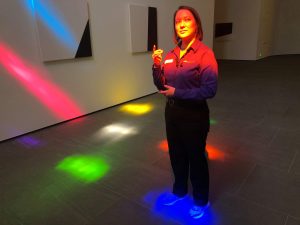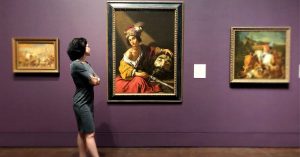The Blanton’s new special exhibition Impressionism and the Caribbean: Francisco Oller and His Transatlantic World offers seemingly infinite possibilities for comparative study. The exhibition includes over 80 paintings that that depict life in more than a dozen countries in Europe and the Americas from the 18th to the early 20th century. Artists from different continents mix and match techniques and styles, depicting the same places in vastly different ways.
So, digital content strategist Alie Cline and I thought, why not make it interesting? Test your visual acuity and art historical chops with this Oller-inspired pop quiz:
1. Which of these 19th-century Caribbean landscapes was painted by a foreign artist, and which was painted by a Caribbean-born artist?
Throughout the colonial period, European and North American artists were drawn to the sun-drenched coasts and lush plant life of Caribbean locales. They traveled throughout the region, painting Romantic, exoticized landscapes devoid of any signs of social turbulence or conflict. In the book that accompanies the exhibition, co-curator Edward J. Sullivan describes paintings of this genre as “landscapes of desire,” idyllic panoramas designed to seduce European and U.S. audiences and encourage foreign investment in the region. Meanwhile, many artists based in the Caribbean, including Puerto Rican painter Francisco Oller, focused their attention on the everyday realities of life in their respective countries and colonies—from local people and landmarks to the ever-present shadow of slavery.
Solution: The idyllic coastal landscape at right, bathed in warm colors and overflowing with tropical foliage, is Jamaica (1871) by Frederic Edwin Church, a celebrated 19th-century American painter and member of the Hudson River School. Sublime elements such as the mountains looming in the background were characteristic of this group’s treatment of nature. The image at left is Francisco Oller’s Hacienda La Fortuna (1885). It depicts a Puerto Rican sugar plantation a decade after the abolition of slavery, including the buildings that made up the complex and the Afro-Puerto Rican workers who comprised its labor force. Oller was known for his sensitive treatment of local subjects, and his work has since come to represent Puerto Rican identity in a time of rapid change.
Left: Francisco Oller.Hacienda La Fortuna, 1885. Oil on canvas, 26 x 40 in. (66 x 101.6 cm). Brooklyn Museum, Gift of Lilla Brown in memory of her husband John W. Brown, by exchange. Brooklyn Museum photograph. Right: Frederic Edwin Church. Jamaica, 1871. Oil on canvas, 14 1/2 x 24 1/4 in. (36.8 x 61.6 cm). Wadsworth Atheneum Museum of Art, Hartford, Connecticut, Gift of E. Hart Fenn in memory of his mother, Mrs. Frances Talcott Fenn.
2. Which of these turn-of-the-century harbor scenes depicts the Texas Gulf Coast?
In Impressionism and the Caribbean, the Caribbean region is defined broadly. It encompasses islands colonized by Spain, France, Great Britain, the Netherlands, Sweden, and Denmark, as well as bordering mainland countries, like Mexico, the United States, and Venezuela. It extends all the way to the coasts of the Gulf of Mexico, which, like the Caribbean Sea, was home to several important commercial ports during the 19th century. These included Galveston, Texas, an immigration hub and a leading port for the export of cotton and wheat—and eventually the import of raw sugar from Cuba.
Solution: Don’t be fooled by the abundance of livestock and wagons in the image at left. If you guessed that the painting on the right depicted Texas, you were correct! German-born painter Julius Stockfleth painted Galveston Wharf Scene in 1885, describing with great detail the city’s bustling harbor. The painting on the left is a never-before-exhibited work by the Catalan painter Manuel Cuyàs Agulló called The Disembarkation of American Troops in Ponce, July 27, 1898 (1898). Copied from a photograph, it depicts the arrival of American naval forces in the Puerto Rican city of Ponce during the Spanish-American War. That war would result in Spain’s ceding of Puerto Rico to the United States by the end of that year.
Left: Manuel Cuyàs Agulló, American Landing in Ponce, 1898, 1898. Oil on canvas, 23 1/2 x 38 3/4 in. (59.7 x 98.4 cm), Gift of José and Mary Jane Fernández, Museo de Arte de Ponce. The Luis A. Ferré Foundation, Inc. Right: Julius Stockfleth, Galveston Wharf Scene, 1885, oil on canvas, Courtesy of Rosenberg Library, Galveston, Texas.
3. What artistic modes or styles influenced each of Oller’s paintings below?
It was Oller’s three sojourns in Paris that most influenced his mature visual vocabulary. There, between 1858 and 1895, the artist worked alongside and under the tutelage of some of the great masters of the early European avant-garde: Gustave Courbet, Camille Pissarro, Paul Cézanne, and Claude Monet, to name a few. He embraced the relatively new practice of painting en plein air or outdoors, which he would harness in depictions of specific locales in both France and Puerto Rico.
Solution: While Oller often painted in a hybrid style, melding elements of what he had learned abroad with local mood, the painting on the left likely relates to the artist’s early experience with the French Realist painters, such as Courbet and Jean-François Millet. The Realists monumentalized the rural and urban laborer, depicting ordinary people as protagonists in socially conscious—and at the time radical—scenes. Oller painted The School of Master Rafael Cordero between 1890 and 1892. In it, he memorializes Rafael Cordero, a self-taught son of freed slaves who went on to open the first school in Puerto Rico for children of all races and social standings.
The image at right, Landscape with Royal Palm (ca. 1897), on the other hand, is undeniably Impressionist-influenced. Here Oller employed short, dot-like brushstrokes and juxtaposed varying shades of green to represent the light-dappled foliage of the palma real, a national icon in his native Puerto Rico. He made the painting soon after his final trip to Paris, where he found inspiration in the late Impressionist experiments of Monet.
Left: Francisco Oller. The School of Master Rafael Cordero, 1890-92. Oil on canvas, 39 x 63 in. (103 x 160 cm). Ateneo Puertorriqueño, San Juan, Puerto Rico. Right: Francisco Oller. Landscape with Royal Palm, circa 1897. Oil on canvas, 18 3/8 x 13 3/4 in. (46.7 x 34.9 cm). Instituto de Cultura Puertorriqueña, San Juan, Puerto Rico.
Stop by the Blanton to see these paintings and more, on view now through Sept. 6.
Beth Shook is the Blanton’s Curatorial Associate for Latin American art and managing curator for Impressionism and the Caribbean: Francisco Oller and His Transatlantic World.





Great idea. Keep the pop quizes comin’